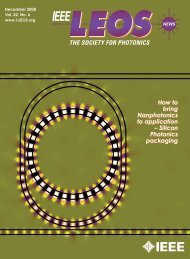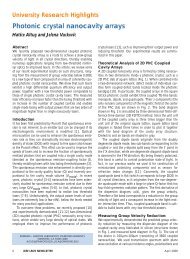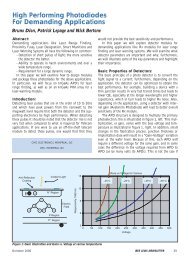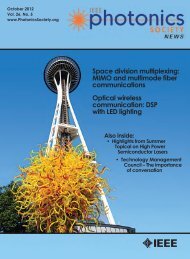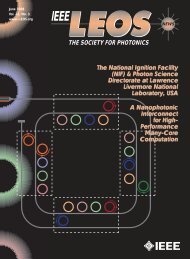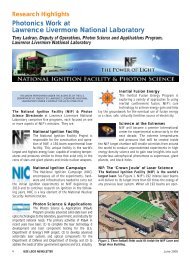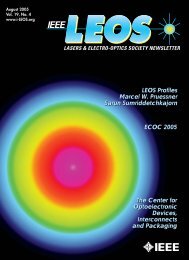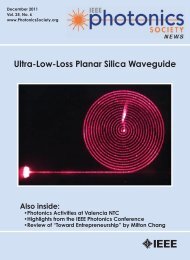Broadband and FTTx â What has been done? Where is it going?
Broadband and FTTx â What has been done? Where is it going?
Broadband and FTTx â What has been done? Where is it going?
You also want an ePaper? Increase the reach of your titles
YUMPU automatically turns print PDFs into web optimized ePapers that Google loves.
electronics must be completely replaced when moving to VDSL,which clearly changes the economic scenario. Of course, if thecopper cable infrastructure <strong>is</strong> still available <strong>and</strong> capable of transportingthe new very high b<strong>it</strong> rates, then the cost of deployingVDSL will still remain far lower than <strong>it</strong>s corresponding fiber technology.However, if c<strong>it</strong>ies adopt leg<strong>is</strong>lation forcing every transporttechnology to be buried in new neighborhoods, thus requiringnew infrastructure to be deployed (Greenfield), then the previousMethodModemT1 LineBy CarFTTHPONSpeed56 Kb<strong>it</strong>/s PC500 Kb<strong>it</strong>/s Cable10 Mb<strong>it</strong>/s100 Mb<strong>it</strong>/sDuration~26 h 12 min~3 h1.5 Mb<strong>it</strong>/s ~1 h~90 km/h ~40 min
Per Subscriber Downstream Line Rate (Mb<strong>it</strong>/s)240220200BPON (622M/1×32) (w RF Video Overlay)GPON (1×32);GPON (1×64); BPON (1.25G/1×32)180EPON (1×16)EPON (1×32 w FEC)160140VDSL2 (30 MHz)VDSL (12 MHz)ADSL2+ (2.2 MHz)120ADSL100806040200 0 1 2 3 4 5 6 7 8 9 10 11 12Prem<strong>is</strong>es Reach (km)Note: W<strong>it</strong>h radio frequency (w RF); w<strong>it</strong>h forward error correction (w FEC)Figure 4. D<strong>is</strong>tance-b<strong>and</strong>width lim<strong>it</strong>ations for various broadb<strong>and</strong> transport technologies20 kmas well as CATV operators, thus explainingthe fierce compet<strong>it</strong>ion. The continuous housingdevelopment (also called Greenfield) alsoensures a permanent growth for operators.Figure 5(a) illustrates typical successful broadb<strong>and</strong>subscription cond<strong>it</strong>ions for the operatorsin North America.However, European culture presentsanother context, where dem<strong>and</strong> <strong>is</strong> not necessarilyas strong as in North America (seeFigure 5(b)). Again, the s<strong>it</strong>uation <strong>is</strong> qu<strong>it</strong>e differentin the Asia-Pacific region, telecommunicationsconsumption (not always broadb<strong>and</strong>)<strong>is</strong> massive due to the dense populationmostly living in multidwelling un<strong>it</strong>s (MDUs)(see Figure 5(c)).Figure 6 illustrates a typical networktopology for a FTTP-related MDU usinghybrid PON-xDSL arch<strong>it</strong>ecture.Th<strong>is</strong> variety of cond<strong>it</strong>ions for broadb<strong>and</strong>consumption offers some potential for <strong>FTTx</strong>,especially FTTC, FTTP <strong>and</strong> FTTH but noteverywhere. Fiber still remains costly toWealthy Middle-Class NeighborhoodIndividually Owned Expensive House W<strong>it</strong>h:Many TV Sets (At Least One HDTV Set)Many PCs w<strong>it</strong>h HS Internet ConnectionsA Phone EverywhereLarge Telecommunication Consumption(a) S<strong>it</strong>uation in North AmericaMDUs EverywhereTV Sets, PCs, Mobiles EverywhereMostly MDUs in C<strong>it</strong>iesTendency to Go Outside <strong>and</strong> in CafesIndividually Owned or Rented Apartment W<strong>it</strong>h:Roughly One TV SetRoughly One PC w<strong>it</strong>h SS Internet ConnectionOne Phone or Even Only a MobileWeak Telecommunication Consumption(b) S<strong>it</strong>uation in Europe (EU)HDTV in Rich NeighborhoodsHuge Telecommunication Consumption300 M+ Internet Subscribers inChina Only <strong>and</strong> Growing(c) S<strong>it</strong>uation in the Asia-Pacific regionFigure 5. Typical subscription cond<strong>it</strong>ions for the operators in various continents8 IEEE LEOS NEWSLETTER April 2008
IEEE MemberDig<strong>it</strong>al LibraryEasy. Effi cient.Powerful. Essential.Staying current inmy work <strong>and</strong> personalinterest areas <strong>is</strong> botheasy <strong>and</strong> affordablew<strong>it</strong>h the IEEE MemberDig<strong>it</strong>al Library.– Wolfgang KrausIEEE MemberD<strong>is</strong>cover how IEEE information can helpfuel your imagination <strong>and</strong> equip you w<strong>it</strong>hthe research you need to compete.Access to all IEEE journals <strong>and</strong>conference proceedings—over1.7 million documentsThe most affordable access,exclusively for IEEE members—under US$2 per articleOnline filing cabinet for convenientaccess to your past research<strong>What</strong> are you wa<strong>it</strong>ing for?BUY NOW.www.ieee.org/ieeemdlIEEE Information Driving Innovation08-PIM-0007-1c-MDL-Kraus-Final.indd 13/21/08 3:26:01 PM
CentralOfficeOLTFTTP PON≤ 20 km of Fiber (One Fiber Only, P2MP)Fiber CopperFigure 7. Example of installation of buried fiber-optic cabledeploy, especially if condu<strong>it</strong> infrastructures must be installed inthe access network, up to the home. For example, in a Greenfielddeployment, FTTH becomes very expensive project, as more than60% of the entire project cost must be allocated to diggingtrenches in order to install the fiber-optic cable (see Figure 7) <strong>and</strong>other infrastructure elements (cabinets, splice enclosures, etc.).In such cases, the North American FTTH model <strong>and</strong> the Asia-Pacific MDU-based FTTP model would tend to offer sufficientreturn-on-investment (ROI) for the telecom companies. In Europe,however, because of the typically short d<strong>is</strong>tances between prem<strong>is</strong>es,the classical FTTC <strong>and</strong> the MDU-based FTTP models would offerthe same relative advantage.Regardless of the specific country <strong>and</strong> context, a set of five maincond<strong>it</strong>ions can be defined to ensure successful FTTP or FTTHdeployment:1. Growing telecom market2. Favorable government policies/regulations3. Educated middle class, interested in using technologies4. Optical fiber used as marketing incentive5. HDTV≤ 300 m Condu<strong>it</strong>Multi-Dwelling Un<strong>it</strong>DSL Modem+ STBDSL Modem+ STBDSL Modem+ STBOONTVDSL2EFigure 6. Typical FTTP topology for MDUs w<strong>it</strong>h hybrid PON <strong>and</strong> DSL arch<strong>it</strong>ectureThe first two cond<strong>it</strong>ions are a must, as in a recession context,there <strong>is</strong> not much chance to see many new developments or governmentincentives in areas perceived to beexpensive. The next two cond<strong>it</strong>ions implythat dem<strong>and</strong> <strong>and</strong> subscriptions for highb<strong>and</strong>widthbroadb<strong>and</strong> services will soar ifthe country’s middle class <strong>is</strong> highly educated,<strong>and</strong> maybe even wealthy <strong>and</strong> interestedin the technology <strong>it</strong>self. Th<strong>is</strong> renders fiberoptics, as a medium, very appealing to theuser, as they recognize how th<strong>is</strong> technologycan provide entertainment <strong>and</strong> improvetheir qual<strong>it</strong>y of life. In that context, FTTP<strong>and</strong> FTTH developers would use fiberbasedservice access in their advert<strong>is</strong>ements<strong>and</strong> promotional material. The last cond<strong>it</strong>ion<strong>is</strong> one of the most important as <strong>it</strong>drives the substantial growth for b<strong>and</strong>widthdem<strong>and</strong> <strong>and</strong>, consequently, providesthe most impressive <strong>and</strong> v<strong>is</strong>ual use ofbroadb<strong>and</strong> access.It would certainly be interesting to verifyif such cond<strong>it</strong>ions could apply to the <strong>FTTx</strong>market s<strong>it</strong>uation around the world as of 2007.Figure 8 below provides a good overall indicator of market tendencies,although the numbers provided in the figures are approximate.Until now, practically all TV channels have <strong>been</strong> transm<strong>it</strong>tedusing analog RF, even for service providers that were early adoptersof FTTH <strong>and</strong> offering video services together w<strong>it</strong>h BPON (seeFigure 9).However, the prospect of transporting video using theInternet protocol (IPTV) <strong>is</strong> an interesting alternative to RF videow<strong>it</strong>h some major benef<strong>it</strong>s such as using the same wavelengths inboth downstream <strong>and</strong> upstream directions, w<strong>it</strong>hout the need foran EDFA, as shown in Figure 10. Once full dig<strong>it</strong>al telecommunicationtransm<strong>is</strong>sions become m<strong>and</strong>atory worldwide, IPTV willopen up the opportun<strong>it</strong>y for video production in small officehome office (SOHO) <strong>and</strong> video transport in both directions. Th<strong>is</strong>may then generate new business opportun<strong>it</strong>ies <strong>and</strong> new add<strong>it</strong>ionalb<strong>and</strong>width requirements. As a “killer telecommunicationapplication” may be defined as a high-speed upstream applicationrequiring even more returned b<strong>and</strong>width downstream, full dig<strong>it</strong>altransport <strong>and</strong> IPTV may then enable such applications <strong>and</strong>bring about the opportun<strong>it</strong>y that everyone in telecom business <strong>is</strong>wa<strong>it</strong>ing for.In 2007, there were approximately 10 million IPTV subscribersworldwide, <strong>and</strong> the growth rate seems to be constant.Th<strong>is</strong> may be taken as an indication that much more IPTVbusiness <strong>is</strong> yet to come.In conclusion, there still remain other interesting questionsthat can be posed as to what the future holds for broadb<strong>and</strong><strong>and</strong> <strong>FTTx</strong>. Will IEEE802.16e WiMAX (worldwideinteroperabil<strong>it</strong>y for microwave access) wireless transport everbecome a serious alternative to deliver triple-play communications—especiallyHDTV? Will <strong>it</strong> become part of the globaltelecommunication transport solution? Will wirelessbecome the communication technology of choice insidehomes in the future? Only time will tell w<strong>it</strong>h certainty, butwe can prepare ourselves w<strong>it</strong>h solid solutions that will serveour purposes for the foreseeable future.10 IEEE LEOS NEWSLETTER April 200830–40 Mb + (3-Play)
CountryUSACanadaChileColombiaArgentinaBrazilOperatorVerizon (BPON); AT&T (GPON)Bell; Telus (Both GPON)TelefonicaEmbratelNumber ofSubscribers~6 M(EssentiallyUS)~0.3 MCountryJapanSouthKoreaOperatorNTT, KDDI, USEN, TEPCO, YahooSoftBankKTSingapore SingtelChinaChina Netcom (EPON), Beijing Netcom(BPON), China Telecom (EPON/GPON),China Mobile (GPON)Hong Kong PCCW, NOW (~0.7 M Active EthernetSubscr.)Taiwan Chunghwa Telecom (GPON)Number ofSubscribers~7 M (EPON)~4 M (BPON,EPON)~5 MTotalMostly BPON (Verizon); a Few GPON~7–8 MTotalMostly EPON (Few BPON <strong>and</strong> GPON)~16–20 M(a) Projects in the Americas(b) Projects in EuropeCountrySwedenItalyNetherl<strong>and</strong>sFranceUKNumber ofOperatorSubscribersBredb<strong>and</strong>s Bolaget (Active Ethernet), MälarenergiStadsnät AB (Active Ethernet), Koping Kabel-TV(GPON), Stadsnäts (Network Association, 200 C<strong>it</strong>ies) ~0.5 MTelecom Italia (GPON), Fastweb (Active Ethernet)C<strong>it</strong>ynet, Portaal, KPN, ETNL, Dansk Bredba<strong>and</strong>,Volker Stevin Telecom, Kenn<strong>is</strong>wijk (All Act. Ethernet)FT Group-Orange (GPON) <strong>and</strong> Eren<strong>is</strong>, PAU<strong>Broadb<strong>and</strong></strong> Country & Free (All Active Ethernet)BT (GPON)~0.5 M~0.6 MDenmarkSydfyns Elforsyning (GPON), Trefor, Energimidt(Active Ethernet)~0.4 MTotal Mostly Active Ethernet; a Few GPON ~2 M(c) Projects in AsiaCountryAustraliaNewZeal<strong>and</strong>Pak<strong>is</strong>tanRussiaKuwa<strong>it</strong>Un<strong>it</strong>ed ArabEmiratesTotalTelstraTelecomNayatelOperatorCenter TelecomKuwa<strong>it</strong> TelecomEt<strong>is</strong>alat; Dubai Internet C<strong>it</strong>yMostly GPON; a Few EPON(d) Projects in the rest of the worldNumber ofSubscribers~2 M~2 MFigure 8. PON <strong>and</strong> active Ethernet <strong>FTTx</strong> worldwide projects in 2007 (~30M total subscribers)April 2008 IEEE LEOS NEWSLETTER 11
COOLTFiber Management SystemService Interfaces1490 nm TxVoice/Data1310 nm RxVideo EDFA1550 nm TxFeeder Cable (F1)Feeder FiberPrem<strong>is</strong>esSpl<strong>it</strong>terFiberD<strong>is</strong>tributionHub (FDH)D<strong>is</strong>tributionCable (F2)DropCabinetDropCable(F3)When Only F2 <strong>is</strong>Used (No F3)ONU/ONT1490 nm RxVoice/Data1310 nm TxVideo1550 nm RxBatteryBackupUser NetworkInterfacesNote: Transm<strong>it</strong>ter (Tx); receiver (Rx); erbium-doped fiber amplifier (EDFA)Figure 9. FTTP PON arch<strong>it</strong>ecture w<strong>it</strong>h analog RF video overlayServiceInterfacesCOOLTVoice/Data/Video1490 nm Tx1310 nm RxFiber Management SystemFeeder Cable (F1)Feeder FiberPrem<strong>is</strong>esSpl<strong>it</strong>terFiberD<strong>is</strong>tributionHub (FDH)D<strong>is</strong>tributionCable (F2)DropCabinetDropCable(F3)When Only F2 <strong>is</strong>Used (No F3)ONU/ONT1490 nm Rx1310 nm TxBatteryBackupUser NetworkInterfacesFigure 10. FTTP PON arch<strong>it</strong>ecture favoring IPTV transport12 IEEE LEOS NEWSLETTER April 2008




